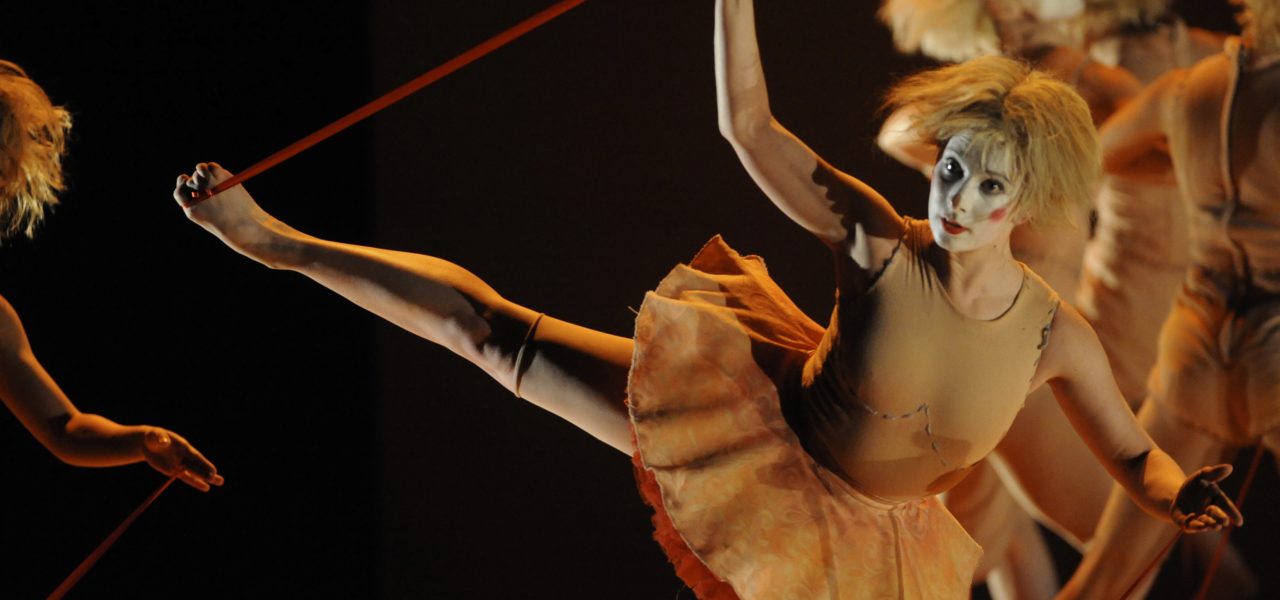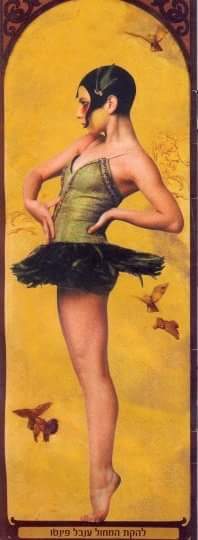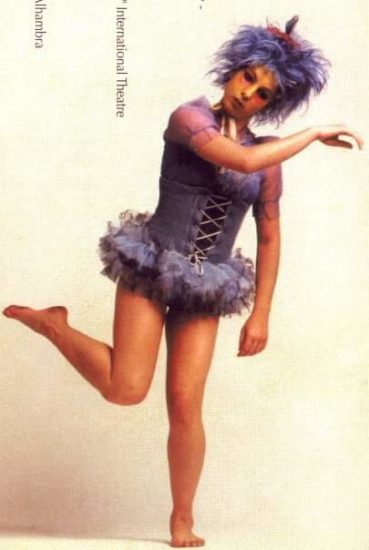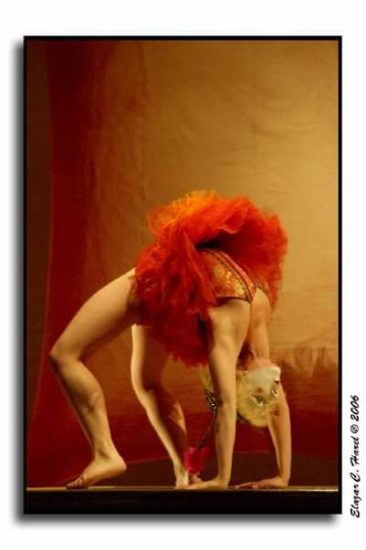An Interview with Noga Harmelin, longtime dancer in Inbal Pinto & Avshalom Pollak Dance Company

 OL: Your name is?
OL: Your name is?
NH: Noga Harmelin.
OL: Where are you from?
NH: From Israel. I grew up in Haifa. I started dancing in Haifa. I have two siblings, I have a brother and a sister. My mother was my first ballet teacher. In junior high I want to Reut High School for three years which was also very ballet, technique-based and a little Martha Graham and character classes. At 15, I went to Mia Arbatova Ballet Competition. I went to the Royal Ballet summer course.
OL: When did you start studying contemporary dance?
NH: Actually, when I was nineteen and came to Tel Aviv. I was at Bat Dor. That was after two years of not dancing and I decided I wanted to pursue it. I got into Bat Dor, into the summer course and then the school for one year and then Jeanette Oldman invited me to join the company. That’s where I started doing contemporary classes. It was a very specific type of contemporary, kind of traditional contemporary.
OL: When did you join Pinto?
NH: 2002. I just turned 23 and after seeing Oyster twice and I sort of knew that this is what I wanted to do. So, I went to the audition, Bat Dor was then having difficulties bringing it up so I sort of understood that I needed to move on so I went to the audition and I got in and since then I’m there.
OL: What was it about Oyster that you liked?
NH: It was the combination of genuine dance language, that I never saw before, with theater, which I always liked. Especially physical theater. I grew up on Chaplin movies and Buster Keaton and all those guys… And then I saw a performance of Marcel Marceau in Haifa in the ‘90s and I fell in love with this kind of mime body language and expression. I think I saw all this in Oyster and I thought it was very much what I wanted to do.
OL: Do you remember the audition?
NH: I remember the audition. It was very hard. Lots of dancers, lots of missions that they gave us to improvise, which was not something I was used to because we didn’t so much improvise in Bat Dor. It was scary but also very exciting.
OL: Did you think you would get in?
NH: I thought I had a chance. I had very strong technique but I thought I was not free enough in my mind.
OL: What was the first production that you did?
NH: We came in while the process of Boobies was going on. All of us were new then. It was Talia Beck and Rotem Gadot and Gwyn Emberton from the UK and two French girls, Celina and Julie, who didn’t stay after. And Zvika and Yuval Sossler and Bosmat Nossan. We were all new and we created Boobies. Only after we premiered Boobies in Antwerp did we come back to learn Oyster.
OL: Since then, how many productions have you been part of?
NH: Wow, I think around 12 or 13.
 OL: Do you have a favorite?
OL: Do you have a favorite?
NH: Well, Oyster definitely is my favorite.
OL: It’s hard to perform, isn’t it?
NH: It’s hard. It’s also the most stressful. Because you really have to be on your legs. It’s the most technical piece. It’s very accurate and there’s no way of faking it. But, it’s also the most enjoyable and I think it’s the most genuine of them all. And the music and the combination of the light and the costumes. Everything just sits perfectly in place I think. But I like them all.
OL: Do you feel that you are playing yourself or playing a role?
NH: That’s a good question. I think I am bringing a different side of myself each time, in every piece. Because we are so involved, except for Oyster and Wrapped, where I wasn’t involved in the process, you can find and relate to your own self inside a certain piece. It’s not like you’re learning a role.
OL: Has working with Inbal Pinto and Avshalom Pollak changed over the years?
NH: Yes, it has. They are different today than they were 15 years ago. I find their work to be darker and sometimes more abstract. Less narrative. More about feelings. But most recently their separation influenced the working process as well.
OL: Last year you did Slug. Was that process very different from previous works?
NH: Yes, it was. Avshalom is amazing in his strong vision of stage an esthetic but he wanted us to be more active in presenting the ideas we’ve been improvising in studio, difficult and challenging ideas, such as Paranoia or schizophrenia and other mental disorders. And the difficult concept of time. How do you create time? Avshalom insisted on us being more active in conveying these ideas through our movement, which was hard. Especially for those of us who are less creative…Some of us have an easy time to create and some of us don’t. Some of us are more inventive, some of us are not.
 OL: Where would you put yourself in that spectrum?
OL: Where would you put yourself in that spectrum?
NH: I am not an inventive kind, I would say… although maybe in a certain situation I could be more. In this time in my life I didn’t find myself very free to create. It was very difficult for me.
OL: Do you feel that the separation created tension in the studio?
NH: In many ways it brought a darker era or darker narrative. However, I felt Avshalom did embrace this as an opportunity to explore something new and different such as dealing with text, which we didn’t do before. Avshalom loves exploring the physical and emotional habits and through this comes the movement and the motivation of the character. Inbal is more about the movement; bringing out the emotional aspects that trigger the narrative. It’s the combination of the two which creates the magic.
NH: No, it’s not sweet in any way. He didn’t want to sweeten it or to make it happy or easy-going on the audience. It’s really his own and the dancers’… because he did let the dancers lead.
OL: It made me wonder if she’s the sweet one.
NH: In many cases, she is. You know, I think it’s the combination of the both. Sometimes she is, sometimes he is. It’s a matter of the time in his life, the separation, letting go of a big relationship in his life is a cause of the darkness. Not necessarily she’s the sweet one. Avshalom can also be very sweet.
OL: You’re working on a new piece now?
NH: Sort of. We are working on an extension of Rushes. We were in the middle, or just the beginning, of a process with her that she was supposed to premiere in March. But she has been ill lately and so the plans changed. They decided that we wouldn’t premiere her piece this year. Avshalom saw that he had to take charge and make a go of an idea he’s had for a long time, to extend Rushes.
 OL: There used to be Rushes Plus.
OL: There used to be Rushes Plus.
NH: Yes, that was because Rushes was created on Pilobolus and it was only half an hour. For us, they added the Plus, which was a collage from different pieces. It’s a beautiful piece but now we are trying to add half an hour more. How do you take a short story and turn it into a novel? How do you open it up again? And is anything missing from it? It feels like no. It’s perfect. But then, I guess, there’s always a way if you try hard enough. And that’s what we are trying to figure out now. We started improvising in the studio with Avshalom and then Inbal came back to the studio two weeks ago. Now we are with her and him also. So, they’re actually working together. I see there is an attempt to work together again.
OL: The performance schedule is so rigorous. How do you keep it fresh after fifteen years?
NH: First of all, not all the shows we do, I’ve done for 15 years. As a dancer, you are different each time; your body, your mind. We are not robots, we are flesh and blood. Every day is so different. I find a lot of richness in their pieces and I think I can always find new stuff to relate to or to discover. Sometimes things fall into place after twenty shows. When we premiere a piece it’s really not the end of the line. There’s always something new coming out. We get a lot of corrections before each performance. There’s always something new to think about. There’s always new dancers coming in, that also changes the piece. If you get a new partner you must adapt to them. That also changes it.
 OL: Do you know what the pieces are about? Is there a narrative and do they share it with you?
OL: Do you know what the pieces are about? Is there a narrative and do they share it with you?
NH: They would if we asked. If there is a narrative and we push, they’ll tell us. But the work is very associative. They want us to be active about finding the meaning.
OL: Do you have a favorite moment from any show?
NH: In Wrapped, there’s the Siamese twins. I really love the simplicity. It’s not presumptuous, it’s very humble.
OL: Do you have a favorite costume?
NH: I think the red Oyster, the gymnast.
OL: If we find you before a performance, three minutes before the curtain goes up, what are you doing?
NH: I am usually stretching like hell. I usually lift my leg, like a do in Oyster. I do that before each show.
OL: You have a child, so you took a break at one point. How was that?
NH: I have been more years in the company as a mother than not. I had Yonatan after seven years and now it’s been eight years since.
OL: Has being a mother changed the way that you work?
NH: Yes, of course. You have this big other thing at home that’s waiting for you, that puts things in proportion, gives you a different perspective. Now I have to go home because I have a child, I can’t linger on in the studio and stretch. It really enriched me. My body changed. It was a bit more round and wide, the pelvis and all. But I felt it was beautiful.
 OL: Does he see you perform?
OL: Does he see you perform?
NH: No. He did twice and he didn’t like it. Sometimes I ask him if he wants to come see and he says no. It’s ok, I respect it. He came on a tour last October to the US and it was amazing. We didn’t have a lot of shows so we could travel. But during the shows he was in the dressing room.
OL: What is the biggest challenge that faces you now?
NH: It’s mostly about getting older. I don’t feel it physically, I feel it mentally.
OL: There’s a rumor you have super human strength.
NH: Not true. But I feel heavier mentally. When we have to improvise for example, I feel heavy about it. It’s hard to invent myself again, to be funny in the studio. I want to be a bit lazier, laid back. That’s also why I think about being less and less in the studio. There’s a big age difference in the company. They are mostly in their 20’s and I’m 38 now, it’s a big difference. I feel far away from them, which is mostly social. I sense this gap more and more and it just gets wider.
OL: Do you ever think about dancing not with a company?
NH: I do. And I would like to try out other stuff.
OL: If you could work with other choreographers, who would you choose?
NH: So many, so many. All of them really.
OL: What is your favorite thing about what you do?
NH: To perform.
OL: Is there a stage you and a normal life you?
NH: Yes. I’m very different in normal life. I feel the same inside but I present something else, I come out as something else. In real life I’m very hesitant, unconfident and on stage I’m not. On stage, I lose it.
In the coming weeks, Inbal Pinto & Avshalom Pollak Dance Company will perform Slug, Wrapped, Oyster and Wallflower. To see the company’s schedule, click here.
